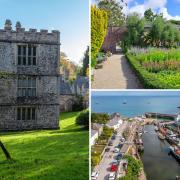Visit the St Ives studio of artist Felicity Mara at the legendary Porthmeor Studios in Cornwall

Felicity Mara’s new show at St Ives’ Penwith Gallery promises a matchless exhibition of pure, perfect abstraction, as MERCEDES SMITH discovers...
Felicity Mara’s Porthmeor Studio is the largest and most idyllic I have seen. Apart from the tranquillity of the space, with its high white walls and wide, pale floorboards, it has perhaps the most spectacular view of any studio in England, facing out across the expanse of Porthmeor beach to the rolling Atlantic surf.
It is midwinter, but the comfort of a smart, modern log burner crackling with heat seems unnecessary since a peculiarly warm sun has lit up the beach outside. As we sit to discuss her most recent paintings, destined for her forthcoming Light On The Wall exhibition at Penwith Gallery this spring, Mara opens a window wide to the ocean breeze. This open window, I discover, is both physically and philosophically important to the paintings that she makes here, paintings of expansive, liquid beauty which explore the fluid boundary between inside and out.
My paintings are not literal depictions of the things around me, but I work with all these things in a sense - the landscape outside my window, the space inside my studio, the changing angles of sunlight, the sounds that float up from the beach – to express a visual equivalent of what’s actually there,’ she explains. I try not to impose my will on a painting. I am more interested in what comes out unconsciously. My paintings are not about things, but about painting itself.’

Historically speaking, the moment when painting liberated itself from visual constraints and became about the act of painting itself is associated with the advent of European Tachism and American Abstract Expressionism in the mid-20th century, a time when painting achieved previously unrivalled purity in the form of Gestural or Action Painting and Lyrical Abstraction.
Accordingly, Mara describes herself as a Lyrical Abstractionist, and her work demonstrates this same intuitive form of expression, the same primacy of colour, shape and line. She creates each work as part of an instinctive, physical event, staining unprimed canvas with highly pigmented colour in a process that has been described in cultural theory as an efflorescence’ – a natural flowering.

The results, in Mara’s case, are mesmerising. Her spacious compositions have a shimmering energy, a hypnotic pull and twist of line paired with the soothing simplicity of vibrant, floating shapes. As is typical of abstract expressionist paintings her canvases are pleasingly large: tall and wide enough to accommodate the energised sweep of the painters arm, they are also large enough to swallow the viewer’s sensory awareness whole.
Her paintings begin with what she describes as a blank canvas moment’, a moment at which the work is about to start and all things are possible. That’s my favourite part of the process, but from then on there is no plan. It’s intuitive. I look, and feel and respond but I don’t know what I’m going to do before I start,’ she tells me in her quiet, considered manner, a manner that seems at odds with the intensely expressive nature of her daily work, and yet mirrors the clarity and depth of feeling her paintings ultimately achieve.
I often start with a line, but from then on the painting just seems to appear’ she continues like a kind of handwriting. I am interested in the way empty space can activate surrounding shapes, in the ambiguous nature of colour and form. My paintings relate to many things and it’s not my intention that they be translated in a single way. It’s an entirely reactive process and I will sometimes write things down as I paint. Words help me hold on to the moment that triggered the work.’
Pinned to the studio walls between her lovely, luminous paintings are pencilled notes on scraps of paper – short poetic sentences and single, bold words. All around the studio, in fact, are countless visual prompts: tiny oil and acrylic sketches, postcards of works by Henri Matisse, Helen Frankenthaler and Linder Sterling, and open books of work by Pierre Bonnard, Ben Nicholson, Turner and Giotto. Between the start and completion of a painting there are pauses, she tells me, sometimes hours, sometimes days, sometimes weeks. I do have to wait for the work to move on,’ she says. It can take a while before I’m able to see what it needs. Often I will move a painting, turn it round, hang it somewhere else in the studio where the light falls differently. It shakes things up and gives me a totally different perspective. I’ll keep working the painting until, visually, the painting makes sense and then I’ll leave it there. It’s important that my paintings don’t look too finished.’
Here in the studio that marine and landscape painter Julius Olsson and abstract painter Sir Terry Frost once occupied, Mara shows me selected works for the Penwith show: huge canvases, smaller paintings and works on paper in a lilting visual language all her own. The choice of gallery is significant. It is a venue historically crucial to the development of abstract art in St Ives, and this new collection of outstanding works are more than equal to the gallery’s considerable legacy. On show from 12 March, Light on the Wall promises a matchless exhibition of pure, perfect abstraction.
Felicity Mara Light On The Wall will be on show from 12 March to 15 April 2015 at Penwith Gallery, Back Road West, St Ives, Cornwall, TR26 1NL.
This article first appeared in Cornwall Life March 2015


























